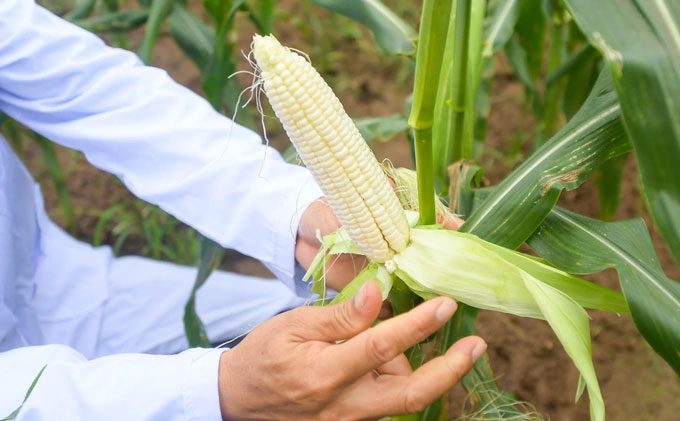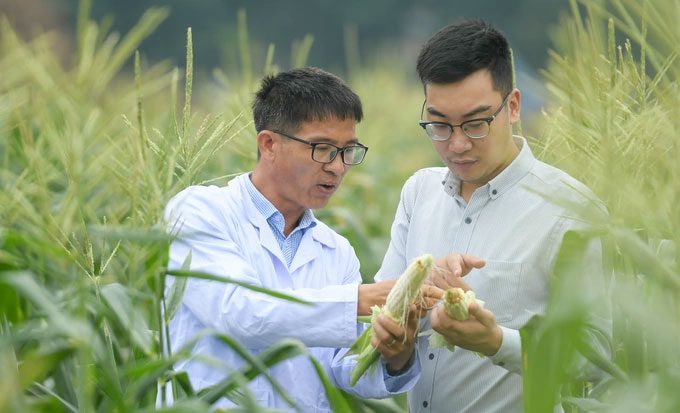After 7 years of research and development, the Crop Research Department – Vietnam Institute of Agricultural Science and Development (Vietnam National University of Agriculture) has launched a new corn variety that can be eaten directly without cooking, steaming, or grilling.
The unique feature of this new corn variety is that it can be eaten like a fruit. It has a high sweetness level and does not have the fibrous texture found in other raw corn varieties.
In an interview, MSc. Nguyen Van Ha, Deputy Head of the Crop Research Department, shared that the SSW18 super sweet corn variety (fruit corn) has been selectively bred using traditional sexual reproduction methods, without genetic modification, and is currently in the trial planting phase.
“This is a new generation of sweet corn with a milky white kernel color, soft texture, and sweetness ranging from 17.5 to 18.5 degrees Brix. Therefore, this sweet corn tastes like ripe fruit and can be consumed raw without any thermal processing. Thus, SSW18 sweet corn can be considered a type of fruit, providing a rich source of essential nutrients and easily digestible fiber,” Mr. Ha confirmed.

Fruit corn cut open showing juicy kernels (Photo: The Hung).

Sweetness ranging from 17.5 to 18.5 degrees Brix. (Photo: The Hung).
Besides being eaten fresh, fruit corn can be blended into juice, milk, smoothies, or other beverages without losing its vitamin content. It can also be stored in the refrigerator for 7-10 days while retaining its freshness and sweetness, similar to other fruits.
This is a significant advantage of the fruit corn variety, as Mr. Ha noted that corn that can be preserved for an extended period will greatly benefit consumers.

Fruit corn harvested weighs about 300-400 grams per ear depending on the growing area. (Photo: The Hung).
After a period of development, the research team has enhanced the growth and rapid development of fruit corn. The time from planting to harvesting fresh ears is 70-80 days, depending on the region and planting season. The yield of fresh corn reaches between 10-12 tons per hectare.
Mr. Ha mentioned that the short cultivation period of fruit corn allows farmers to plant multiple crops throughout the year and harvest them in succession. Notably, this corn variety has been developed domestically, making it highly adaptable and particularly suitable for areas with intensive farming conditions or cooler climates.

The short cultivation period allows multiple plantings throughout the year. (Photo: The Hung).
In the near future, the research team plans to introduce this corn variety to mountainous regions such as Moc Chau, Sapa, and Bac Ha. These areas are traditional corn-growing regions with strong tourism development, contributing to poverty alleviation and the potential to become local specialty crops. In fact, corn grown in these areas yields larger ears compared to those grown in the plains and significantly reduces pests and diseases.
“Especially, since fruit corn is eaten fresh, it requires a special organic cultivation process, ensuring food safety and hygiene, and not using mineral fertilizers or chemicals…”, the Deputy Head of the Crop Research Department mentioned.

Fruit corn is juicy, sweeter than watermelon. (Photo: The Hung).
After trying the fruit corn, Ms. Mai Anh (Gia Lam, Hanoi) shared: “The corn has a juicy feel and tastes sweeter than watermelon without being chewy. Eating it feels like consuming a ripe fruit. Fruit corn would be very convenient if I don’t have time to prepare breakfast in the morning. Additionally, this type of corn can be a great addition to salads, providing a fragrant and rich flavor to the dish.”


















































